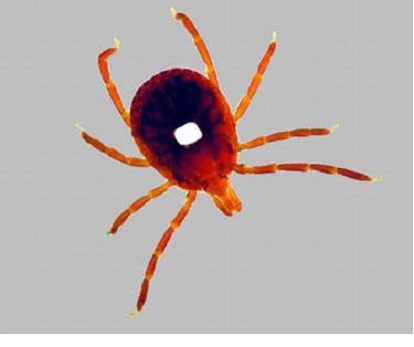Lone Star Ticks Becoming Active
Outdoor activities and spring cleanup provide chances to enjoy the outdoors after a long winter. Removing some of the ‘things’ that have accumulated over the winter is hard but rewarding work as long as picking up ticks isn’t part of the ‘reward.’
Lone star tick nymphs and adults (Figure 1) are active now and searching for a blood meal. They climb low vegetation and wait with outstretched front legs to latch on to passing animals or humans. Once “on board,” they crawl around to find a suitable place to attach and feed. The painful feeding site can be irritating for days after the tick has detached or been removed.
Personal Protection Against Ticks
Here are some things to do to protect against ticks and their bites:
• Don’t walk through uncut fields, brush, and overgrown areas, especially during April-July. Walk in the center of mowed trails to avoid brushing up against vegetation. Avoid or minimize time in tick habitats.
• When hiking or camping in tick-infested areas, wear light-colored clothing and long pants tucked into boots or socks
• Consider using tick repellent. Use personal protection – repellents (DEET or picaridin) or permethrin-based clothing sprays. Inspect your clothing and body regularly and remove ticks, especially at the end of the day. Take a warm soapy shower after potential tick exposure. Wash clothing in hot water and detergent – store in sealed bag until it is washed.
• Inspect family and pets after being in tick prone areas. Ticks often attach at the waist, armpit, neck and scalp, but can attach virtually anywhere. Promptly remove any ticks, using the method discussed below.
Dealing with Ticks in the Landscape
Ticks do not do well in open yards and landscapes. Regular mowing reduces humidity, removes essential protection from direct sunlight, and generally reduces the chances for ticks to survive for long. In addition, homeowners should keep shrubs trimmed, and clear overgrown vegetation from edges of the property. Ticks and their wild hosts will not normally infest areas that are well maintained. A good way to confirm if ticks are present is to drag a white flannel cloth or sheet through suspected areas. Ticks will attach and be visible against the white background.
In rural areas, ticks are most likely to be found along shady edges of woods or overgrown areas. Treating a 10 foot buffer of lawn along these margins can reduce tick numbers it is rarely useful to treat open areas. Concentrate along borders and fences, and between overgrown areas and the lawn. Insecticide sprays containing pyrethroid active ingredients permethrin, cyfluthrin, bifenthrin or lambda-cyhalothrin (e.g., Bayer Advanced Home/Garden Multi-Insect Killer, Spectracide Triazicide, Ortho Home Defense System) or carbaryl (Sevin) are effective. Such products are sold at hardware and lawn and garden shops. For better wetting and coverage of vegetation, it is often best to purchase these products as concentrates so that they can be diluted and applied with a hose end or pump up sprayer. One to two applications during late April/May and perhaps mid-summer is often all that’s required.
Ticks and Pets
Free-roaming pets are more likely to become infested than if confined. Pets may pick up ticks that drop off indoors. Ticks on pets can be controlled or prevented using sprays, spot-ons, and insecticide-impregnated collars. See a veterinarian for appropriate products.
Tick Removal
Attached ticks should be removed promptly to reduce the chance of infection and disease transmission.
• Using a tweezers, grasp the tick as close to the skin as possible and pull it straight out with gentle even pressure.
• Wash the bite area, apply antiseptic, and cover with a Band-Aid.
• Petroleum jelly, hot matches, and other ‘folk’ methods of removal should be avoided.
For more information, contact the Butler County Extension Office at 112 E GL Smith Street, Morgantown, or call 270-526-3767.
Educational programs of the Kentucky Cooperative Extension Service serve all people regardless of race, color, age, sex, religion, disability, or national origin.
By: Greg Drake II, County Extension Agent for Agriculture and Natural Resources
Source: Lee Townsend, Extension Entomologist
- Log in to post comments



























